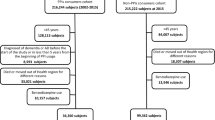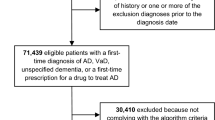Abstract
Purpose
The aim of this study is to determine the prevalence of use and long-term use (≥180 days) of proton pump inhibitors (PPIs) and associated factors among community-dwellers with and without Alzheimer’s disease (AD).
Methods
MEDALZ cohort encompassed all persons who received a verified diagnosis of AD in Finland during the years 2005–2011 and their age-, sex-, and region of residence-matched comparison persons, including 69,353 persons with and 69,353 persons without AD. Data was derived from several Finnish administrative registers. A mathematical modelling method, PRE2DUP, was used for converting dispensing data to drug use periods (when regular PPI use started and ended). Morbid conditions and concomitant drugs associated with use and long-term use of PPIs were assessed with logistic regression models.
Results
Use of PPIs was more common among comparison persons than persons with AD (39.0 and 35.8%, respectively, p < 0.001), whereas long-term use of PPIs was more frequent among persons with than without AD (20.3 and 17.9%, respectively, p < 0.001). Factors related to long-term use of PPIs were female sex, history of gastrointestinal bleedings, AD, rheumatoid arthritis, cardiovascular disease, asthma/COPD and use of bisphosphonates, SSRIs and antithrombotic agents. Median follow-up time was 2.6 years among persons with AD and 3.5 years among persons without AD. Median duration of the first long-term PPI use was similar in both groups (1.4 years).
Conclusion
Long-term use of PPIs was common among persons with and without AD. Due to possible adverse events associated with the long-term use of PPIs, need for PPIs should be assessed regularly.
Similar content being viewed by others
References
Shi S, Klotz U (2008) Proton pump inhibitors: an update of their clinical use and pharmacokinetics. Eur J Clin Pharmacol 64(10):935–951
Masclee GM, Sturkenboom MC, Kuipers EJ (2014) A benefit-risk assessment of the use of proton pump inhibitors in the elderly. Drugs Aging 31(4):263–282
Reimer C (2013) Safety of long-term PPI therapy. Best Pract res Clin Gastroenterol 27(3):443–454
Canadian Institute for Health Information (2009) Proton pump inhibitor use in seniors: An analysis focusing on drug claims, 2001 to 2008. https://secure.cihi.ca/free_products/PPI_aib_en.pdf. Accessed 7th February 2017
Haastrup PF, Paulsen MS, Christensen RD, Søndergaard J, Hansen JM, Jarbøl DE (2016) Medical and non-medical predictors of initiating long-term use of proton pump inhibitors: a nationwide cohort study of first-time users during a 10-year period. Aliment Pharmacol Ther 44(1):78–87
Moriarty F, Bennett K, Cahir C, Fahey T (2016) Characterizing potentially inappropriate prescribing of proton pump inhibitors in older people in primary care in Ireland from 1997 to 2012. J am Geriatr Soc 64(12):e291–e296
Othman F, Card TR, Crooks CJ (2016) Proton pump inhibitor prescribing patterns in the UK: a primary care database study. Pharmacoepidemiol Drug Saf 25(9):1079–1087
Pottegård A, Broe A, Hallas J, de Muckadell OB, Lassen AT, Lødrup AB (2016) Use of proton-pump inhibitors among adults: a Danish nationwide drug utilization study. Therap Adv Gastroenterol 9(5):671–678
Hamzat H, Sun H, Ford JC, MacLeod J, Soiza RL, Mangoni AA (2012) Inappropriate prescribing of proton pump inhibitors in older patients: effects of an educational strategy. Drugs Aging 29(8):681–690
Rane PP, Guha S, Chatterjee S, Aparasu RR (2017) Prevalence and predictors of non-evidence based proton pump inhibitor use among elderly nursing home residents in the US. Res Social Adm Pharm 13(2):358–363
Wallerstedt SM, Fastbom J, Linke J, Vitols S (2017) Long-term use of proton pump inhibitors and prevalence of disease- and drug-related reasons for gastroprotection—a cross-sectional population based-study. Pharmacoepidemiol Drug Saf 26(1):9–16
Mangoni AA, Jackson SH (2004) Age-related changes in pharmacokinetics and pharmacodynamics: basic principles and practical applications. Br J Clin Pharmacol 57(1):6–14
Sosa-Ortiz AL, Acosta-Castillo I, Prince MJ (2012) Epidemiology of dementias and Alzheimer’s disease. Arch med res 43(8):600–608
Haenisch B, von Holt K, Wiese B et al (2015) Risk of dementia in elderly patients with the use of proton pump inhibitors. Eur Arch Psychiatry Clin Neurosci 265(5):419–428
Gomm W, von Holt K, Thomé F et al (2016) Association of proton pump inhibitors with risk of dementia: a pharmacoepidemiological claims data analysis. JAMA Neurol 73(4):410–416
Booker A, Jacob LE, Rapp M, Bohlken J, Kostev K (2016) Risk factors for dementia diagnosis in German primary care practice. Int Psychogeriatr 28(7):1059–1065
Tjia J, Rothman MR, Kiely DK, Shaffer ML, Holmes HM, Sachs GA, Mitchell SL (2010) Daily medication use in nursing home residents with advanced dementia. J am Geriatr Soc 58(5):880–888
Cojutti P, Arnoldo L, Cattani G, Brusaferro S, Pea F (2016) Polytherapy and the risk of potentially inappropriate prescriptions (PIPs) among elderly and very elderly patients in three different settings (hospital, community, long-term care facilities) of the Friuli Venezia Giulia region, Italy: are the very elderly at higher risk of PIPs? Pharmacoepidemiol Drug Saf 25(9):1070–1078
Teramura-Grönblad M, Hosia-Randell H, Muurinen S, Pitkälä K (2010) Use of proton pump inhibitors and their associated risks among frail elderly nursing home residents. Scan J Prim Health Care 28(3):154–159
Tolppanen AM, Taipale H, Koponen M, Lavikainen P, Tanskanen A, Tiihonen J, Hartikainen S (2016) Cohort profile: the Finnish medication and Alzheimer’s disease (MEDALZ) study. BMJ Open. doi:10.1136/bmjopen-2016-012100
McKhann G, Drachman D, Folstein M, Katzman R, Price D, Stadlan EM (1984) Clinical diagnosis of Alzheimer’s disease: report of the NINCDS-ADRDA work group under the auspices of department of health and human services task force on Alzheimer’s disease. Neurology 34(7):939–944
American Psychiatric Association (1994) Diagnostic and statistical manual of mental disorders, 4th edn. Washington, DC
World Health Organization (2003) Introduction to Drug Utilization Research. pp 33–35. http://apps.who.int/medicinedocs/pdf/s4876e/s4876e.pdf. Accessed 14th December 2016
Tanskanen A, Taipale H, Koponen M, Tolppanen AM, Hartikainen S, Ahonen R, Tiihonen J (2015) From prescription drug purchases to drug use periods—a second generation method (PRE2DUP). BMC med Inform Decis Mak. doi:10.1186/s12911-015-0140-z
Finnish Medicines Agency Fimea (2015) National OTC medicines programme. Serial Publication Fimea Develops, Assess and Informs 1/2015. http://www.fimea.fi/documents/160140/765540/28627_KAI_1_2015_EN.pdf. Accessed 4th January 2017
Scarpignato C, Gatta L, Zullo A et al (2016) Effective and safe proton pump inhibitor therapy in acid-related diseases—a position paper addressing benefits and potential harms of acid suppression. BMC Med. doi:0.1186/s12916-016-0718-z
Savarino V, Dulbecco P, de Bortoli N, Ottonello A, Savarino E (2017) The appropriate use of proton pump inhibitors (PPIs): need for a reappraisal. Eur J Intern Med 37:19–24
Poh CH, Navarro-Rodriguez T, Fass R (2010) Review: treatment of gastroesophageal reflux disease in the elderly. Am J Med 123(6):496–501
Pilotto A, Franceschi M, Maggi S, Addante F, Sancarlo D (2010) Optimal management of peptic ulcer disease in the elderly. Drugs Aging 27(7):545–558
Hamina A, Taipale H, Tanskanen A, Tolppanen AM, Tiihonen J, Hartikainen S (2017) Differences in analgesic use in community-dwelling persons with and without Alzheimer’s disease. Eur J Pain 21(4):658–667
British Geriatric Society (2013) Guidance on the management of pain in older people. Age Aging 42:i1–i57
American Geriatrics Society Panel on the pharmacological management of persistent pain in older persons (2009) Pharmacological management of persistent pain in older persons. J Am Geriatr Soc 57(8):1331–1346
Finnish Medical Society Duodecim, Helsinki (2015) Current care: rheumatoid arthritis (in Finnish with English summary). http://www.kaypahoito.fi/web/kh/suositukset/suositus?id=hoi21010#s9_1. Accessed 31st March 2017
Wedzicha JA, Miravitlles M, Hurst JR et al (2017) Management of COPD exacerbations: a European Respiratory Society/American Thoracic Society guideline. Eur Respir J. doi:10.1183/13993003.00791-2016
Global Initiative for asthma (2017) Global strategy for asthma management and prevention (2017 update). http://ginasthma.org/2017-gina-report-global-strategy-for-asthma-management-and-prevention/. Accessed 31st March 2017
Hughes CF, Ward M, Hoey L, McNulty H (2013) Vitamin B12 and ageing: current issues and interaction with folate. Ann Clin Biochem 50(4):315–329
Haukka J, Suvisaari J, Tuulio-Henriksson A, Lönnqvist J (2007) High concordance between self-reported medication and official prescription database information. Eur J Clin Pharmacol 63(11):1069–1074
Rikala M, Hartikainen S, Sulkava R, Korhonen MJ (2010) Validity of the Finnish prescription register for measuring psychotropic drug exposures among elderly Finns: a population-based intervention study. Drugs Aging 27(4):337–349
Taipale H, Tanskanen A, Koponen M, Tolppanen AM, Tiihonen J, Hartikainen S (2016) Agreement between PRE2DUP register data modelling method and comprehensive drug use interview among older persons. Clin Epidemiol 8:363–371
Author information
Authors and Affiliations
Contributions
HJ analysed data and wrote the paper. All authors contributed on study design and commented on and edited the article.
Corresponding author
Ethics declarations
Funding
None received for this study.
Conflict of interest
SH has received lecture fees from MSD and Professio. HT, JT and AT have participated in research projects funded by Janssen and Eli Lilly with grants paid to the institution where they were employed. AT is a member of Janssen advisory board. JT has served as a consultant to Lundbeck, Organon, Janssen-Cilag, Eli Lilly, AstraZeneca, F. Hoffman-La Roche and Bristol-Myers Squibb. He has received fees for giving expert opinions to Bristol-Myers Squibb and GlaxoSmithKline, lecture fees from Janssen-Cilag, Bristol-Myers Squibb, Eli Lilly, Pfizer, Lundbeck, GlaxoSmithKline, AstraZeneca and Novartis; and grant from Stanley Foundation. JT is a member of advisory board in AstraZeneca, Janssen-Cilag and Otsuka. Other authors declare no conflicts of interest.
Electronic supplementary material
ESM 1
(DOCX 12 kb)
Rights and permissions
About this article
Cite this article
Juntunen, H., Taipale, H., Tanskanen, A. et al. Long-term use of proton pump inhibitors among community-dwelling persons with and without Alzheimer’s disease. Eur J Clin Pharmacol 73, 1149–1158 (2017). https://doi.org/10.1007/s00228-017-2273-8
Received:
Accepted:
Published:
Issue Date:
DOI: https://doi.org/10.1007/s00228-017-2273-8




